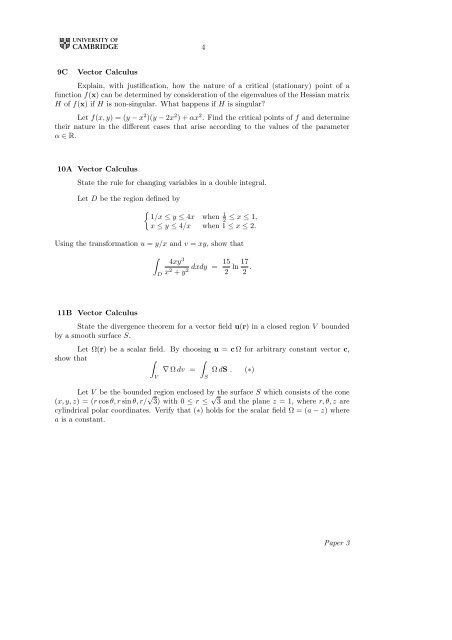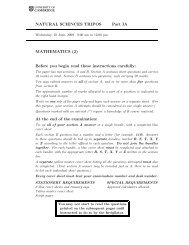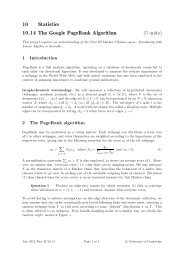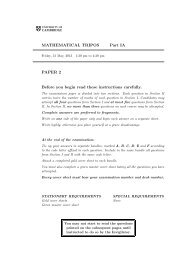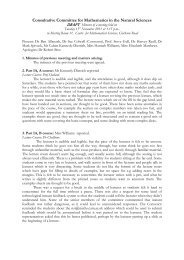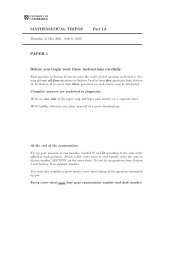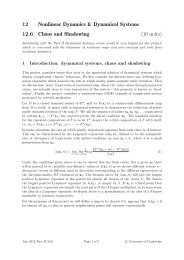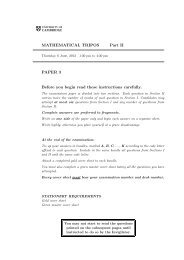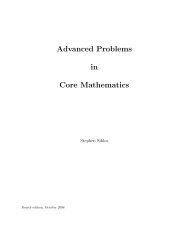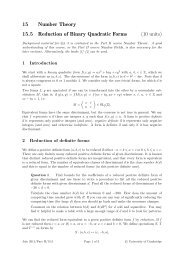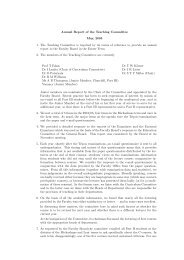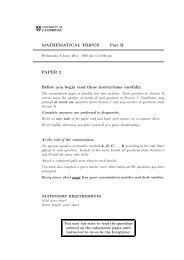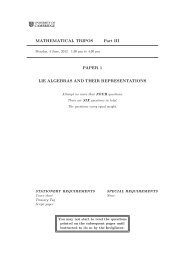MATHEMATICAL TRIPOS Part IA PAPER 3 Before you begin read ...
MATHEMATICAL TRIPOS Part IA PAPER 3 Before you begin read ...
MATHEMATICAL TRIPOS Part IA PAPER 3 Before you begin read ...
Create successful ePaper yourself
Turn your PDF publications into a flip-book with our unique Google optimized e-Paper software.
4<br />
9C<br />
Vector Calculus<br />
Explain, with justification, how the nature of a critical (stationary) point of a<br />
function f(x) can be determined by consideration of the eigenvalues of the Hessian matrix<br />
H of f(x) if H is non-singular. What happens if H is singular?<br />
Let f(x, y) = (y − x 2 )(y − 2x 2 ) + αx 2 . Find the critical points of f and determine<br />
their nature in the different cases that arise according to the values of the parameter<br />
α ∈ R.<br />
10A Vector Calculus<br />
State the rule for changing variables in a double integral.<br />
Let D be the region defined by<br />
{<br />
1/x ≤ y ≤ 4x when<br />
1<br />
2 ≤ x ≤ 1,<br />
x ≤ y ≤ 4/x when 1 ≤ x ≤ 2.<br />
Using the transformation u = y/x and v = xy, show that<br />
∫<br />
D<br />
4xy 3<br />
x 2 + y 2 dxdy = 15 2 ln 17 2 .<br />
11B Vector Calculus<br />
State the divergence theorem for a vector field u(r) in a closed region V bounded<br />
by a smooth surface S.<br />
Let Ω(r) be a scalar field. By choosing u = c Ω for arbitrary constant vector c,<br />
show that<br />
∫<br />
∫<br />
∇ Ω dv = Ω dS . (∗)<br />
V<br />
Let V be the bounded region enclosed by the surface S which consists of the cone<br />
(x, y, z) = (r cos θ, r sin θ, r/ √ 3) with 0 ≤ r ≤ √ 3 and the plane z = 1, where r, θ, z are<br />
cylindrical polar coordinates. Verify that (∗) holds for the scalar field Ω = (a − z) where<br />
a is a constant.<br />
S<br />
Paper 3


